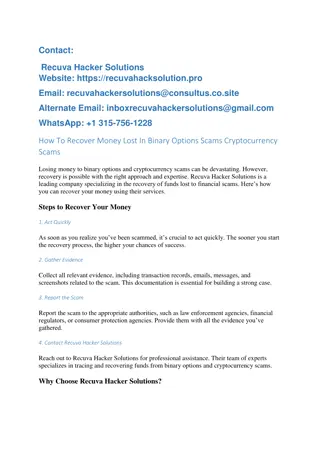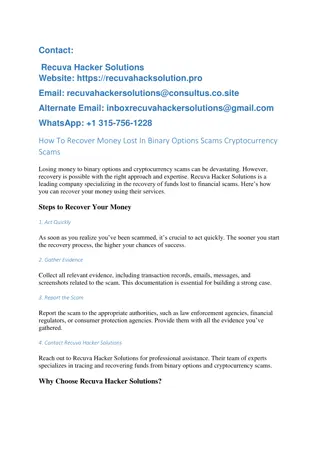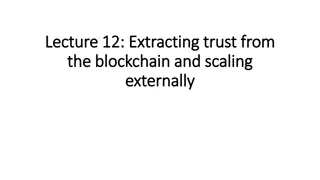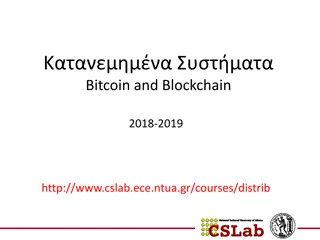Exploring the Computer Science Behind Bitcoin
Delve into the technical aspects of Bitcoin, understanding its role as a digital currency, transaction processes, blockchain technology, and the use of cryptographic hashing and public key encryption. Uncover the challenges faced by digital currencies and the innovative technologies used to address them.
Download Presentation

Please find below an Image/Link to download the presentation.
The content on the website is provided AS IS for your information and personal use only. It may not be sold, licensed, or shared on other websites without obtaining consent from the author. Download presentation by click this link. If you encounter any issues during the download, it is possible that the publisher has removed the file from their server.
E N D
Presentation Transcript
The Computer Science Behind Bitcoin PAUL HRYCEWICZ COMPUTER SCIENCE MARCH 10, 2020
What is Money? A medium of exchange Something which has actual or perceived value Something which is scarce Scarce by its nature, or Scarcity by fiat What is Bitcoin? One of several digital currencies A mainstream medium of exchange, accepted and used by many individuals and businesses. So it has perceived value. It has built-in scarcity
Using Bitcoin A user sends and receives BTC to other users. That transfer is represented by a transaction. Transactions reside in blocks. Blocks are linked together in chronological sequence and form the blockchain. The blockchain is the system of record, open to everybody. Users rely on digital signatures to make sure that BTC goes only to the intended recipient. Transaction granularity is 1 satoshi, .00000001 BTC (one one-hundred-millionth BTC, today $0.00001) My wallet can scan the blockchain and tell me how much bitcoin I have. It does this by summing the value of all the transactions that gave me BTC and subtracting the BTC I sent to somebody else. To spend money, I create a transaction sending some of my accumulated BTC to somebody else. Everybody can detect if I try to spend more money than I have, and reject my attempt.
Bitcoin wallet Users generally use a wallet as the interface into the BTC environment. Each BTC user has a unique anonymous address, for example 1BvBMSEYstWetqTFn5Au4m4 GFg7xJaNVN2 This is an example of a pay-to-public-key hash address (P2PHK)
Bitcoins use of Technologies Problems that need to be handled by a digital currency: 1. How do we ensure that transactions are secure? 1a. Ensure money goes only to its intended recipient 1b. Ensure money is coming from whom we think it is 2. How do we maintain the scarcity of the currency? 3. How do we maintain a system of record? 4. How do we maintain the integrity of the currency? Technologies used to solve these problems: Cryptographic hashing Public key encryption Mining (proof-of-work) Blockchain public distributed ledger Network (lest we forget)
Problem # 1: Transaction Security Problem 1A. How do we make sure that when we transfer BTC, it goes only to the intended recipient?
Background: Cryptographic Hashing Public-Key Cryptography
Cryptographic Hashing The origin of cryptographic hashing can be traced back to the work in 1961 by W. Wesley Peterson, then at IBM, regarding data transmission error protocols. Peterson s problem: You re sending data over an imperfect transmission line. How can you determine if the data you sent was received correctly? Peterson developed something called a checksum which was transmitted along with the data. The received data must match its checksum; else an error occurred. Today: Cryptographic hashing creates a unique signature for a piece of data. Current state-of-the-art: the SHA-256 algorithm SHA-256 hash Data
Cryptographic Hashing Generating the SHA-256 hash of a given piece of data is relatively quick and easy. Anybody that hashes the same data gets the same hash. Even a small change in the data results in a large change in the resulting hash. See https://xorbin.com/tools/sha256-hash-calculator Using SHA-256, there are 2**256 different possible hashes. This is a HUGE number. It is not (practically) possible to determine the original data from its hash. Common usages of cryptographic hashing are verifying file integrity and for the storing of passwords.
Public Key (Asymmetric) Cryptography Developed in 1975 by Whitfield Diffie and Martin E. Hellman (Stanford). Problem: How to send a secure message over an insecure transmission line? (insecure = somebody may be listening) (secure = only the intended recipient can decode and read the message) This can be solved if both parties have the same shared key. But how do you share a key securely? Solution: Use a pair of keys. This is known as Diffie-Hellman cryptography. Released as PGP (Pretty Good Privacy) in 1991 by Phil Zimmerman.
Public Key Cryptography A user creates two keys: a private key, kept secret a public key, seen by everybody The public key is mathematically derived from the private key, using some additional numbers which are also kept private. Two well-known methods of key generation are RSA (Rivest Shamir Adelman) and ECC (elliptic-curve cryptography) The linkage between keys is one-way: a public key can easily be generated from a private key, but a private key cannot be determined from its public key Generating a public/private key pair is reasonably straightforward. See: https://qsandbox.com/tools/private-public-keygen
Public Key Cryptography Data that has been encrypted using one key can be decrypted with the other. The longer the key, the harder it is to break. There is currently no known method of breaking the commonly-used public/private key functionality.
Public Key Cryptography B wants to be able to receive secure messages. B publishes its public key. A wants to send a secure message to B A B message encrypted message encrypted message encryption decrypted message decryption B s public key B s private key As long as B s private key stays private, nobody can decrypt the message. The message is secure. B can send a secure message to A by reversing the process.
Problem 1A. How do we make sure that when we transfer BTC, it goes only to the intended recipient? Solution use public key cryptography. Only the recipient can decipher the transfer.
Problem # 1B: Transaction Security Problem 1B. How do we make sure that a transaction is coming from the person we think it is, and not an impostor?
Authentication (Digital Signature) Can be accomplished using a combination of cryptographic hashing and public key encryption A wants to send B a message, and B wants to ensure that it was sent from A A message send message and signature to B hash function hash A s signature encrypt A s private key
Authentication (Digital Signature) B Yes, the message came from A, and, the message has not been tampered with hash function message hash Are the hashes equal? A s signature decrypt hash No, the message is counterfeit A s public key
Problem 1B. How do we make sure that a transaction is coming from the person we think it is, and not an impostor? Solution: Use a digital signature.
Problem # 2 How do we maintain BTC scarcity?
Mining (Proof-of-Work) Roots in email spam detection system Cynthia Dwork (Harvard), Moni Naor (UCB) 1991. Question: How to detect if an incoming email is spam? Have the sender expend some proof of work which is insignificant if sending one email, but burdensome if sending to many recipients. Sender: To: From: Date: Subject: Body: Does the resulting hash start with 20 zero bits? Yes - send hash function add 1 to nonce and try again nonce No
Mining (Proof-of-Work) Receiver: To: From: Date: Subject: Body: Does the hash start with 20 zero bits? Yes, it s a valid email hash function nonce No, it s spam Assume on a typical sender machine, it takes 0.25 second of CPU time to develop the nonce. For one email, that s insignificant. For 1,000,000 spam emails, each with a different to:, that s 69 hours of compute time.
Bitcoin Mining yes, get reward (currently 12.5 BTC) hash until you get approx. 46 zero bits Block of transactions were you the first? No, try again with next block nonce
Mining hardware My Surface Pro 3 with an Intel i5-4300 can do about 6.5 megahashes/second (MH/s) Recent estimates shows 5.92653E+22 hashes (9 billion trillion) needed before a reward can be claimed That would take my laptop 31 billion years to compute This device the Innosilicon T3+ - does 67 TH/s ($2,000 retail) You can expect to mine .41 BTC/year with a power cost of $2,312 (US Bay Area) or $867 (China) 1 BTC = about $8,619 (Jan 19)
Problem # 2 How do we maintain BTC scarcity? Solution: Require bitcoins to be mined.
Problem # 3 How do we maintain a system of record?
Transferring Money How do banks do this today? Each bank maintains a system of record for their accounts (centralized ledger database) Problem: A wants to transfer $10 from their bank account, to B s account in a different bank Similar to the Two Generals Problem Solution: Need a trusted third party to act as the coordinator. could be one of the banks could be a Paypal or a Venmo If we have a trusted third party, then we can use the Two-Phase Commit protocol
Two-Phase Commit The instructions for transfer are sent to both banks Both banks databases log the upcoming change but do not change the actual databases The trusted third party tells each bank prepare to commit (Phase 1) Each bank logs the upcoming transaction, and tells the coordinator OK The trusted third party waits for a response from each bank If the trusted third party receives positive responses from each bank, meaning that the logging was successful, it tells each bank to commit (Phase 2) Each bank writes the change to its database
Two-Phase Commit If the coordinator fails during processing, the commit is never issued, so integrity of both databases is maintained If a bank fails before it receives the prepare, it never responds, so the commit is never issued If a bank fails after it sends a positive response but before it executes the commit, that bank s log contains the record, so the database can be adjusted Bank databases exhibit the ACID property
But Bitcoin does not operate like a bank By design, There is no centralized ledger in a Bitcoin network There is no Bitcoin database There is no trusted third party in a Bitcoin network There can be no two-phase commit
Bitcoin Data Structure: Transaction Every user of BTC is represented by a unique address Any BTC user can send BTC to any other user via a transaction Each transaction contains the identifier of the sender a reference to BTC owned by the sender could be from a single previous transaction could be from multiple previous transactions the identifier of the recipient authentication instructions for the recipient (typically via signature) Transactions are not encrypted
Bitcoin Data Structure: Block Transactions are grouped into blocks By design, one new block is created every 10 minutes When a transaction is placed into a block, and the block is added to the blockchain, the transaction is said to be authenticated, and the recipient can use those BTC So, it takes an average of 5 minutes for a transaction to complete The 2019 BTC transaction rate was roughly 5 transactions/second
Blockchain Based on initial work by Ralph Merkle (Stanford, UCB) 1979, Stuart Haber and W. Scott Stornetta (1991) (Columbia), (Stanford, Bellcore), then by Satoshi Nakamoto (2008) In a distributed network like Bitcoin, there are no banks there are no bank accounts there is no trusted third party there is no centralized database with ACID properties containing account balances there is the possibility of bogus transactions it has only an insecure network Bitcoin uses a distributed public ledger the ledger can be used to show balances everybody can have a copy the content of the ledger is agreed upon by consensus of the users
Bitcoin Blockchain previous block s hash previous block s hash previous block s hash . . . this block s hash this block s hash this block s hash this block s hash Genesis Block Transaction Blocks One new block enters the chain every 10 minutes Each block contains the transactions from that time interval Each transaction contains a sender, a receiver, and the number of BTC being transferred
Bitcoin Blockchain Transactions go into a pool Miners grab the transactions, place them into a working block, and try to develop the nonce for that block When a miner is successful, it broadcasts its success to the network Anybody on the network can verify the nonce, and everybody that s interested can grab the new blockchain It s possible that two or more miners generate a successful hash at the same time This causes a fork in the blockchain . . . . . .
Bitcoin Blockchain The next block s miner will choose one fork or the other for the new block That fork is now longer than the other, and since everybody can see the blockchain, everybody sees that it s longer New blocks are always added to the longer fork Transactions from the shorter block go back into the pool, where they are picked up by miners The integrity of the blockchain is therefore maintained
Problem # 3 How do we maintain a system of record (in a widely-distributed system)? Solution: Use a blockchain.
Problem # 4: How do we maintain the integrity of the currency?
Transaction integrity The pointer from one block to the previous is the SHA-256 hash of that block. Everybody can verify that the new block contains the correct hash of the previous block, And everybody can verify that the hash of the current block is correct. So we conclude that the block is legitimate. Everybody can see the transactions in the new block. Everybody can see all the previous transactions that form the inputs for each new transaction. Everybody can verify that those transactions add up to enough BTC for the new transaction s transfer amount. So we conclude that the transactions are legitimate. If a block and its transactions are legitimate, users add it to their copy of the blockchain. If it s not legitimate, users don t add it to their copies. As long as 50%+1 users accept a block as legitimate, it is.
Transaction integrity Let s say somebody tries to change a transaction in a previous block. The hash of that block changes. Everybody can see that the hash contained in that block is incorrect, and therefore the change is bogus. So the change is rejected. Let s now say somebody changes a transaction in a block and the hash contained in the block. They would have to re-mine the nonce for that block. If they did that, the block, by itself, looks correct. But the next block in the chain (the more recent block) would no longer point to (no longer contains the hash of) the changed block, so Everybody can see that the chain is broken, and can reject the change. In theory, somebody could change a block, and change all the pointers from that block to the newest.
Problem # 4: How do we maintain the integrity of the currency? Solution: Even though many of the details of a transaction are hidden, everybody can see the high points, so everybody can validate.
Bitcoin Statistics As of Jan 19 2020, the number of BTC in circulation is 18.1M (there is a design cap of 21M) www.blockchain.com There are approximately 614,000 blocks Average transaction rate: 3.28 / second Average transaction size is 500 bytes Average size of each block is 1MB The average transaction value is $19,000
Thank You! And have a great semester!
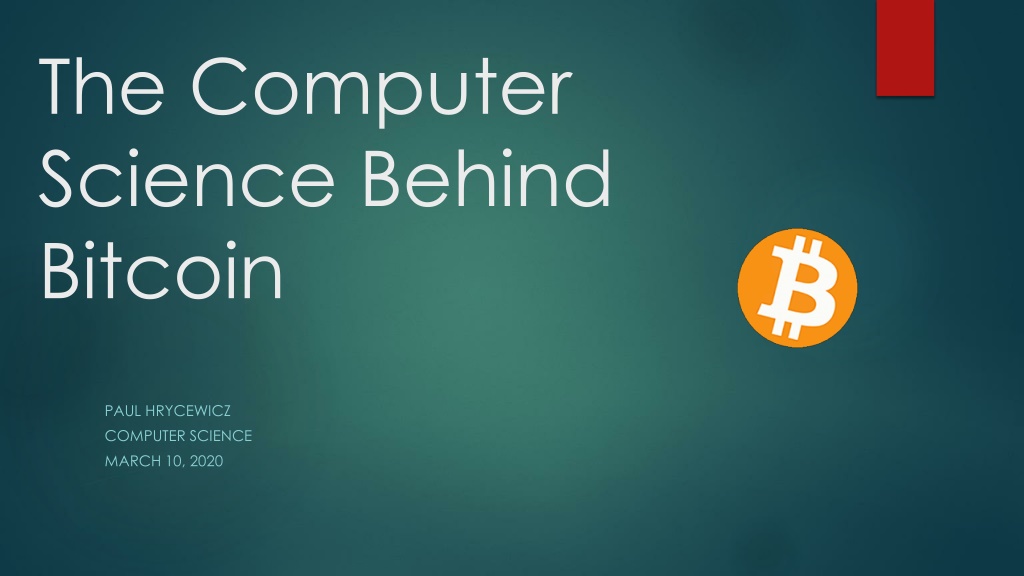


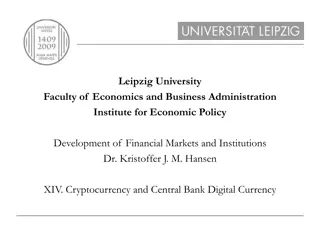




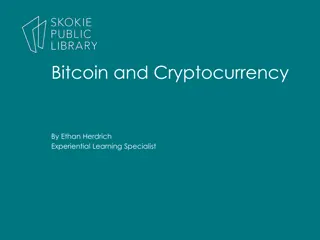
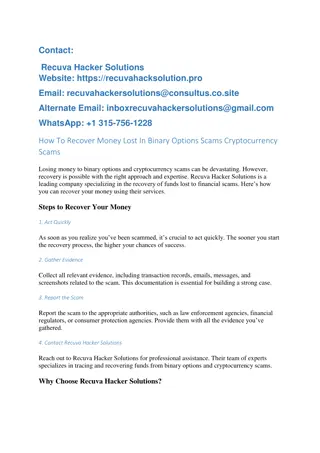
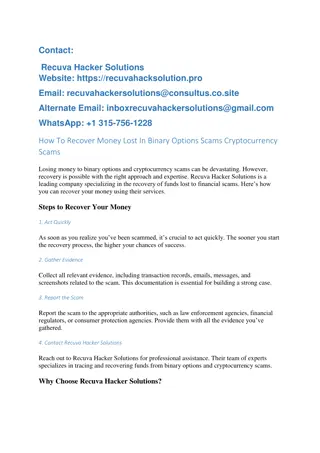
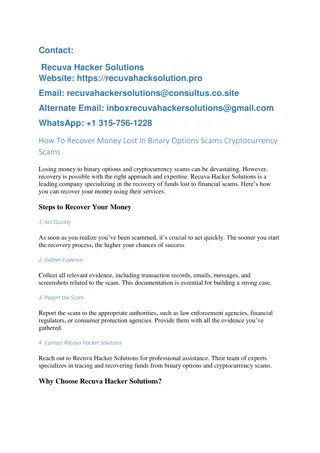
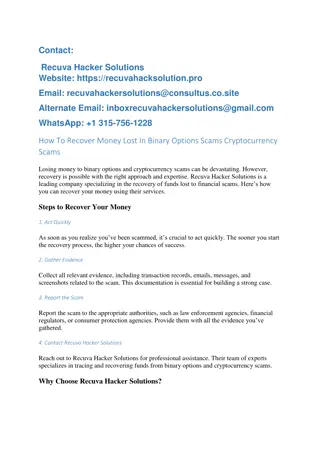
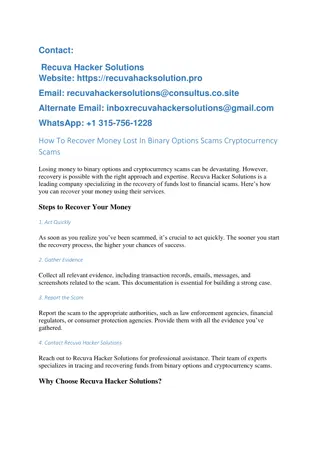
![101 Reviews How to Recover Lost Bitcoin [Scammed/Stolen Funds]](/thumb/153354/101-reviews-how-to-recover-lost-bitcoin-scammed-stolen-funds.jpg)

